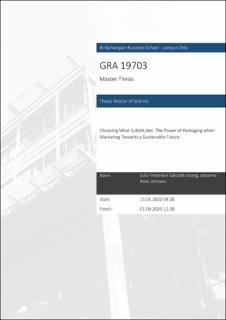Choosing Meat Substitutes: The Power of Packaging when Marketing Towards a Sustainable Future
Master thesis
Permanent lenke
https://hdl.handle.net/11250/2687452Utgivelsesdato
2020Metadata
Vis full innførselSamlinger
- Master of Science [1621]
Sammendrag
The meat consumption of the modern world is slowly eating away at our planet’s
natural resources. Consumer awareness and governmental regulations surrounding
more sustainable food production, has created an area of innovation for products
that are meant to replace meat in the diet. Meat substitutes are entering the market
in a rapid pace but are yet to gain consumers’ acceptance and share of wallet. The
purpose of this study is to determine how to take advantage of visual stimuli on
product packaging to increase purchase intention for this relatively new and
unexplored food category.
An experimental survey using a within-subjects factorial design was selected to
investigate drivers behind purchase intention and the participants’ belief in the
environmental friendliness of meat substitutes, as well as the effect of
environmental involvement. The results show that using the color green on
product packaging is an important driver for both environmental belief and
purchase intention for meat substitutes. There is a striking difference between men
and women in terms of intent to purchase but they have similar beliefs in
environmental friendliness of meat substitutes. Participants with different levels of
environmental involvement portray contrasting behaviors in relation to the belief
in the environmental friendliness of meat substitutes and intent to purchase. The
study also suggests that the belief in environmental friendliness of meat
substitutes do not mediate the relationship between visual stimuli on the product
package, gender and purchase intention.
The study provides insight into future directions for marketing managers of meat
substitutes. The results indicate that a sustainability approach to marketing of
meat substitutes will only be effective for some groups of consumers. The thesis
contributes with an understanding of consumers perception of marketing tools
used on product packaging, and recommendations on how to take advantage of
these tools.
Beskrivelse
Masteroppgave(MSc) in Master of Science in Strategic Marketing Management - Handelshøyskolen BI, 2020
